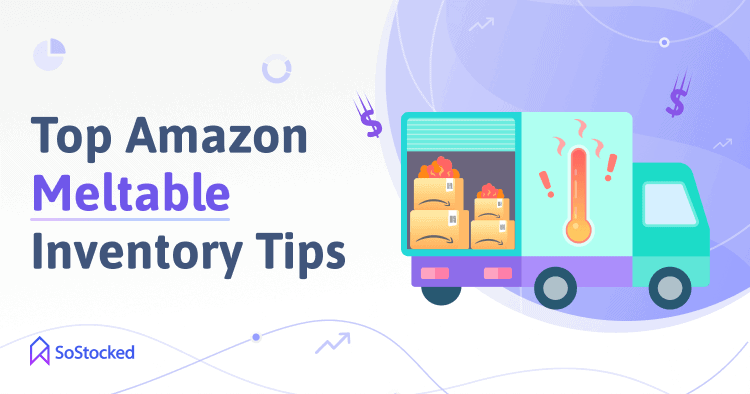
5 Top Tips for Selling Amazon Meltable Inventory
Understanding Seasonal Inventory Restrictions + Selling Tips to Avoid Incurring Losses
Amazon meltable inventory refers to heat-sensitive products that will not be able to withstand summer temperatures. When stored in a hot and humid environment, these products will not maintain their quality and will therefore, become unsellable.
Unfortunately, it’s difficult and expensive for Amazon to maintain low temperatures at their warehouses during the hotter months. Plus, most trucking companies that do FBA fulfillment deliveries do not have refrigerated trucks. So, imagine what the temperature in the back of a cramped non-refrigerated truck would feel like during summer in Austin, Texas.
For that reason, Amazon has put seasonal restrictions on meltable inventory in place to protect your customers from receiving melted products and to help you avoid incurring significant losses – non-compliance may result in surprise disposal of your meltables.
With that in mind, it’s crucial to understand Amazon’s meltable inventory requirements to stay compliant at all times and ensure your customers are receiving their orders intact and in good condition.
Read on to learn more about Amazon’s meltable product restrictions and our top tips for selling meltables via FBA.
In this Amazon Meltable Inventory guide, we’ll take a look at:
What is Amazon Meltable Inventory?
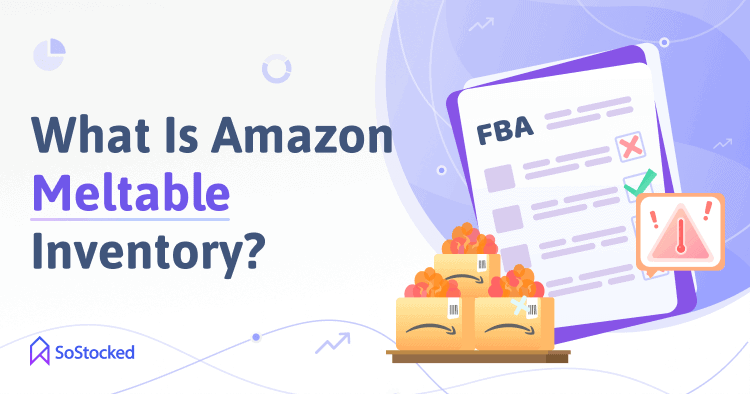
Also known as heat-sensitive inventory, meltables are products that will melt under high temperatures for any length of time.
To prevent damage to these products during storage and shipping, Amazon has implemented rules for selling and fulfilling meltables in the FBA program. These include:
FBA availability window
As of May 2022, you cannot sell meltable products from April 15 to October 15. Amazon updates their policy periodically, so make sure to check the news announcements on Seller Forum every once in a while to stay updated.
Disposal start date
Any meltables in your existing inventory past the April 15 deadline must be removed from FBA. You can create a removal order to:
- Authorize Amazon to dispose of your meltable inventory
- Send your meltable inventory back to your warehouse
- Liquidate your meltable inventory
Temperature requirements
Some temperature-sensitive products may be exempted from the Amazon Meltable Inventory Policy if they can withstand summer temperatures ranging from 75 to 155 degrees Fahrenheit (24 to 68 degrees Celsius). If you believe your product should not be classified as “meltable,” get a letter from your manufacturer that confirms it can be stored at up to 155 degrees F (68 degrees C) for extended periods. Then, send the letter to Seller Support, who will then verify the information with your manufacturer.
Read Meltable FBA Inventory Policy to learn more.
Amazon Meltables List
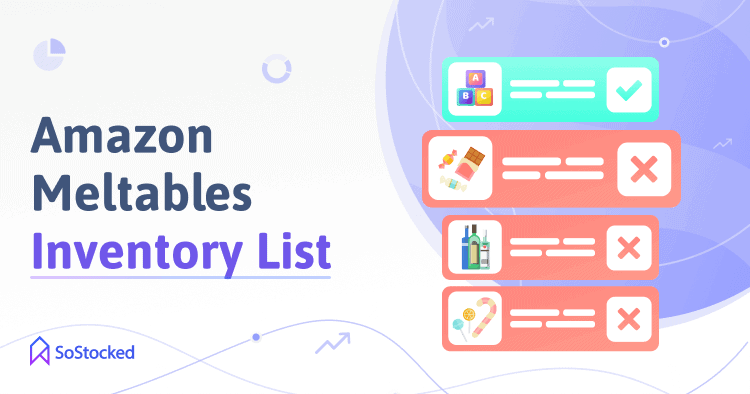
The Amazon meltable inventory list typically consists of:
- Chocolates, including chocolate-coated wafers, doughnuts, etc.
- Gummies (eg., many hemp gummies contain gelatin that melts at 90-95 degrees F or 32-35 degrees C)
- Select jelly- and wax-based products
But there are also some gray areas out there. For instance, some sellers will still sell consumables with meltable ingredients like chocolate chips during the warmer months, while others classify them as meltable.
Amazon has also recently been marking other temperature-controlled products like cosmetics as meltable, too.
So, how do you know if your product is meltable?
- Check Amazon’s Meltable ASINs (Excel) to see if your product or ASIN is on the list. This file is updated periodically, and usually on or before March 1 in preparation for the upcoming April 15 inventory disposal start date.
Pro tip: Use this free ASIN Lookup Tool or the FBA Revenue Calculator to quickly identify the meltables on the list.
2. Determine your product’s melting point. You can do this by asking your supplier about the melting temperature of your heat-sensitive product or running a melting point experiment yourself using the capillary method. This method involves putting the sample in a capillary tube (a narrow cylindrical glass tube) and heating the tube with a burner until the sample reaches melting point. Use a thermometer to measure the temperature and then record it. Suppose the sample melts at anywhere between 75-155 degrees F (24-68 degrees C). In that case, it can be considered meltable based on Amazon’s meltable inventory policy.
To give you some idea, cocoa solids (one of the main ingredients of chocolates) normally melt at around 80 degrees F (27 degrees C), while chocolate ganache melt at room temperature or 68 to 77 degrees F (20 to 25 degrees C). Given this, it’s best to sell chocolates (of all kinds) online in the winter rather than summer. But if you still want to sell meltables this summer via FBM, perhaps limit your delivery areas to nearby (and colder) cities. It may also be necessary to use insulated packaging materials to provide additional heat protection. More on that later.
When to Sell Meltables on Amazon?
Amazon only accepts meltable inventory between October 16 and April 14. Again, no meltable shipments can be sent into FBA between April 15 and October 15. So, be careful when selecting products to ship to fulfillment centers during the hotter months as Amazon is pretty strict with enforcing their meltable inventory policy. Amazon may receive your heat-sensitive products, but they will mark them as unfulfillable, and thus subject them to disposal.
Note: Meltable products are different from perishable products. Meltables are seasonal goods that you can only sell on Amazon mostly during winter, while perishable products are not suited for FBA and are prohibited year-round in the program, as they require constant refrigeration, freezing, or air-conditioning. Examples include fruits, fresh meats, and veggies.
5 Tips for Selling Meltable Products using FBA

Check if Your Meltable Product is Eligible for FBA
Not all products are eligible for FBA. So before listing your meltables with Amazon, it’s crucial to determine what’s suitable for your selected fulfillment method and what isn’t. For instance, FBA sellers are prohibited from selling alcoholic drinks, car tires, counterfeit goods, and damaged goods on the retail site.
For more details on FBA inventory restrictions and requirements, check out the following pages:
- Categories and Products that Require Approval
- Amazon Product Restrictions
- Expiration-Dated FBA inventory
Related: 14 Mistakes Sellers Make When Shipping to Amazon FBA and How to Unlock Gated Amazon Categories
Build an Efficient Replenishment Process
Given that you have a very limited FBA availability window, it’s best to build a solid replenishment process for your meltables. Plus, seasonal products like chocolates tend to sell out fast during the holiday season.
A good replenishment process should include:
- Running an inventory forecast to determine your projected demand. This will help you ensure you’ll have enough inventory to last through your key selling period. For a more accurate calculation, use an advanced online management software like SoStocked to factor out sales spikes and stockouts from your forecasts. Factoring in abnormal sales spikes (that are not going to occur again), for example, can lead to over-ordering, which may then result in excess inventory. And if that excess meltable inventory remains unsold on April 15th, it will also cost you in removal fees and, more than likely, other costs and losses.
- Setting a reorder point. As the name suggests, reorder point is the stock level at which your FBA meltable inventory needs to be replenished. You can set and automate your minimum (aka buffer stock) and maximum stock quantities using SoStocked to ensure efficient restocking.
- Inventory tracking. In SoStocked, you can create purchase orders (POs) and assign lead times to your POs to enable online inventory tracking. Here’s a lead time flow example:
- In Production: 30 days
- Ocean freight: 40 days
- Truck freight: 5 days
- FBA check-in: 10 days
- Total lead time: 85 days
If 85 days is too long, try to work out a shorter lead time with your supplier and freight forwarder. For instance, your freight forwarder might recommend shipping a portion of your inventory by air and the rest by ocean so you can have some stock ready for sale before peak season.
Knowing your anticipated demand, automating your reorders, and creating lead times will allow you to plan ahead so you can avoid stockouts. Schedule a demo call with us to learn more.
Keep Your Product’s Expiration Date in Mind
Most meltable products lose their quality with time. To ensure customers get their products in good condition, your expiration-dated inventory should allow sufficient time to be consumed in full, plus an additional 90 days in order to be checked into Amazon and then sold through.
Therefore, products within 50 days of the expiration date at the time of arrival at Amazon will be automatically disposed of. Unfortunately, this means your products will not be sent back to you.
When you’re sending meltables into FBA warehouses, they have to be processed for check in (which usually takes 5 to 10 days) and still have more than 3 months left on their shelf life. Avoid cutting it close by accounting for time for the inventory to ship to FBA and the time for it to be received and possibly distributed across multiple fulfillment centers.
To keep track of your expiration-dated meltables, use the First In, First Out (FIFO) method, wherein you track each batch of each ASIN with expiration dates and dates you sent them into Amazon. Expiration dates are already required by Amazon’s policies and they then work to sell the older products first to avoid spoilage, though it isn’t a perfect system.
Finally, create a sales reminder for your inventory in Google calendar so you’ll be alerted when it’s time to amp up your advertising efforts to increase your sell-through before the expiration date or disposal start date.
Related: Types of Inventory that Amazon Sellers Should Know About
Increase the Sales of Meltable Products before April 15th or Expiration Date
If your in-stock meltable inventory is higher than your projected demand between today and April 15th or its expiration date, you should take action immediately.
Consider putting your unsold products on sale or using other marketing tactics to increase your product’s Sales Velocity. You could also increase your advertising budget to reach a larger audience for your inventory to sell through it quickly.
However, if none of these steps work and you still have a lot of unsold meltables left at FBA, consider creating a removal order and have Amazon return them to you. This way, you can still try to sell them through alternative channels even after the April 15 disposal date. But in some cases, it might make more business sense to just let Amazon get rid of your unsold meltables versus paying removal fees to have them sent back to your warehouse. Plus, if you factor in transit time and potential delays, the risk of receiving your returned meltables in bad condition is quite high.
Run a cost analysis to figure out the estimated cost of disposing of any unsold meltable items versus the cost of returning them to your warehouse (and potentially investing more money on shipping fees and marketing to increase sell-through) on April 15th.
Related: Amazon FBA Fee Calculator Tool
If using FBM, Use Additional Packaging for Better Heat Protection
If you’re going to switch to FBM to sell meltables during the summer months, you’ll need to invest in gel ice packs (refrigerant, thermoplastic materials to keep your packages cool), bigger cartons, and other packaging materials to ensure better heat protection.
For example, using a carton that’s at least 2 or 3 times the size of your meltable product may help keep heat away from the goods inside the box. Packing it with some insulated mylar bubble wraps (reflective insulating material) or adding in ice gels packs could also provide a bit of a heat barrier.
However, keep in mind that your transit time and the types of heat (conductive heat, convective heat, and radiant heat) that will pass through the packages are going to influence the size and amount of these heat-resistant materials.
For example, products in transit may be exposed to radiant heat. It’s the type of heat that travels from one item to another without direct contact (like sun rays bouncing from object to object) versus:
- Conductive heat that passes from a part of an object to another through direct contact, e.g., heating a skillet on a stove.
- Convective heat that travels from one object or place to another through the movement of liquid or gas, e.g., boiling water (hot water rises while cool water sinks). Chocolates usually turn into blobs of goo when exposed to boiling point temperature (100 degrees C or 212 degrees F).
The point is to be aware of cities in the US that get really hot temperatures during the summer months and add extra insulated packaging materials to ensure heat protection whenever necessary.
If you’re using a small carton, you might need to add in 2 to 4 ounces of ice gel packs. If you’re shipping to a city that gets really hot during summer, consider adding more cold packs. It’s also best to put these packs in a ziplock to make sure it doesn’t leak drops of condensed water on your products.
To shorten transit time, book Priority or Express shipping (2-3 day shipping) for summer deliveries. Shipping across long distances, specifically places with scorching temperatures, may not be ideal, unless you can afford next-day shipping.
Overall, the additional packaging materials needed to provide a better heat barrier for your meltables can come at an extra cost. But then again, no customer wants to receive a melted product. You need to ensure your products can withstand temperature fluctuations during storage and shipping, regardless of whether you’re using FBA or FBM.
Manage Your Amazon Meltable Inventory with SoStocked
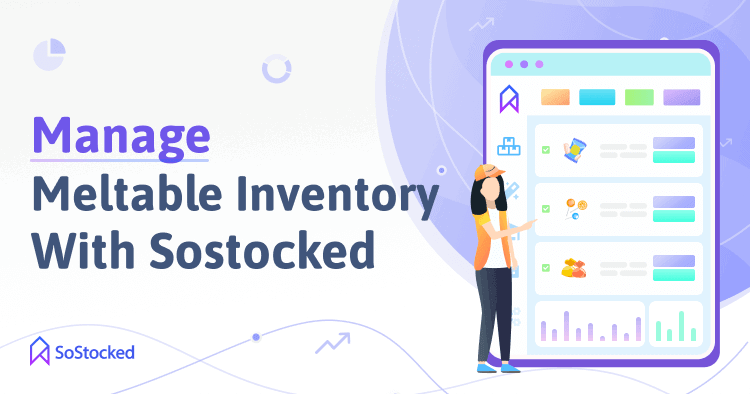
Use the tools below to better manage your meltables:
Amazon Meltable Inventory Dashboard
Create a Meltable Inventory Dashboard by adding a tag for your chocolates, gummies, among other meltables, applying filters, and saving your new dashboard for easier inventory management.
Product Tagging Tool
Classify meltables using our product tagging tool – for example, tagging chocolate bars as “Meltable.” You can also use this tool to view specific data by tags in the Forecast page so that you can apply changes to those tagged items only, reducing errors.
Work Order Management System
Aside from Purchase Orders, you can also create Work Orders (WO) in SoStocked. Our WO management system allows you to make instructional documents that you can share with your 3PL or prep center. Your WOs can include information about your 3PL to FBA transfer times, as well as other work requests:
- Store or ship your meltable products once they arrive at the warehouse
- Receive and store inventory at your 3PL warehouse
- Bundle multiple meltables into a single pack
- Or, a combination of any of the above requests
Min/Max Restocking
Reduce the risk of over- and under-ordering by setting a range for your minimum and maximum stock for 3PL and FBA. You set your Min-Max in units or in days, although it would be best to set it to In Days, as sales will fluctuate depending on seasonality.
Follow Meltable Inventory Guidelines to Minimize Losses
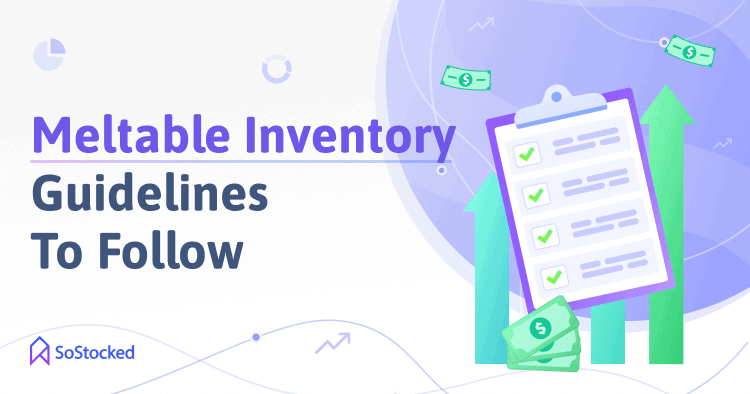
Amazon makes it possible for you to turn your passion for chocolates (or other meltables) into a lucrative FBA business by allowing you to sell meltable products from October 16 to April 14.
However, certain seasonal inventory restrictions are put in place to make sure you don’t send in products that will melt or crumble at high temperatures. Remember, Amazon is all about providing excellent customer service. If a customer complains about receiving melted chocolates or wax-based makeup products like lip balms (melting point at 100 degrees F or 38 degrees C), it will negatively impact your customer review ratings and Seller Performance on Amazon.
No seller wants that.
So, it’s best to familiarize yourself with these product restrictions and follow these selling tips to ensure you don’t end up with lots of unsold meltables before the disposal date.
Before starting a meltable product business, take the time to do inventory forecasting to ensure you stay in stock throughout your target selling period. Also, being mindful of your meltable inventory at the end of the FBA availability window can help you maximize your sales while minimizing the costs associated with inventory shrinkage (losses incurred due to unsellable inventory, for example).
Use SoStocked to manage your Amazon meltable inventory. Create a dedicated dashboard for your meltable products, perform sales forecasts, set your reorder point, and create purchase orders or work orders to track your inventory along the supply chain.
Need more information?
- Send Message: We typically reply within 2 hours during office hours.
- Schedule Demo: Dive deeper into the nuances of our software with Chelsea.
- Join Live Upcoming Webinar: New to Amazon inventory management? Learn three inventory techniques you can implement right away.
 Get Started
Get Started